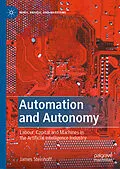This book argues that Marxist theory is essential for understanding the contemporary industrialization of the form of artificial intelligence (AI) called machine learning. It includes a political economic history of AI, tracking how it went from a fringe research interest for a handful of scientists in the 1950s to a centerpiece of cybernetic capital fifty years later. It also includes a political economic study of the scale, scope and dynamics of the contemporary AI industry as well as a labour process analysis of commercial machine learning software production, based on interviews with workers and management in AI companies around the world, ranging from tiny startups to giant technology firms. On the basis of this study, Steinhoff develops a Marxist analysis to argue that the popular theory of immaterial labour, which holds that information technologies increase the autonomy of workers from capital, tending towards a post-capitalist economy, does not adequately describe the situation of high-tech digital labour today. In the AI industry, digital labour remains firmly under the control of capital. Steinhoff argues that theories discerning therein an emergent autonomy of labour are in fact witnessing labour's increasing automation.
James Steinhoff is a Postdoctoral Fellow at the University of Toronto, Canada
Autorentext
James Steinhoff is a Postdoctoral Fellow at the University of Toronto, Canada.
Inhalt
1. Introduction: Automation, Autonomy and Artificial Intelligence
Your Means of Production
Revolutions
AI in the Real World
Machinery and Marxists
The Central ArgumentComputing Machinery
Recursion
What this Book is NotChapter Outline
2. Labour, Capital, Machine: Marxist Theory and Technology
IntroductionPolitical Economy
Marx on Value and Labour
Marx on MachinesThe Fragment on Machines
Marxism(s)
Soviet MarxismWestern Marxism
Labour Process Theory
The New Reading of MarxCybernetic Capitalism
Conclusion
3. Post-Operaismo and the New Autonomy of Immaterial Labour
Introduction
From Operaismo to Post-operaismo
Post-operaismoImmaterial Labour Theory
Human-Machine Hybridization
Abstract CooperationNew Autonomy from Capital
The Technological Argument for New Autonomy
ConclusionIntroduction
The Historical ContextThe Advent of AI Research
The AI Winter
Expert Systems: The First Era of the AI IndustryStrategic Computing: AI and the State Part I
The Decline of Expert Systems
The Rise of Machine LearningDeep Learning: The Second Era of the AI Industry
Conclusion
5. Machine Learning and Fixed Capital: The Contemporary AI Industry
Introduction
Charting the AI Industry
AI Capital CompositionAI Tech Giants
AI Dinosaurs
AI Startups
AI Think Tanks
National AI Strategies: AI and the State Part II
AI Capital Concentration
Open Source AI, Clouds, AI Chips
Labour in the AI IndustryLabour Composition: Race and Gender
AI Labour Organization
Conclusion
6. A Dark Art: The Machine Learning Labour Process
Introduction
The Machine Learning Labour Process
Stage 1: Data Processing
Stage 2: Model Building
Stage 3: Deployment
The Commodity Form of AI
Empirical Control
AI as Automation
The Automation of AI Work
Automated Machine Learning
Synthetic AutomationOther Forms of Automation in Machine Learning
Conclusion
7.New Autonomy and Work in the AI Industry
Introduction
AI Work and Human-Machine Hybridization
AI Work and Abstract CooperationAI Work and New Autonomy
Autonomy for What?
ConclusionIntroduction
Theoretical SynthesisAutomation on Steroids
Optimism and Agency
Conclusion